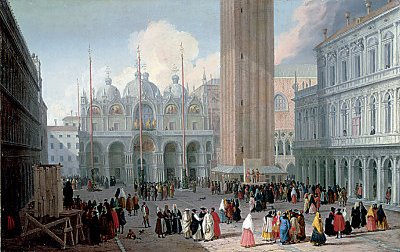 |
|
VENICE: PIAZZA SAN MARCO TOWARDS THE CHURCH
OF SAN MARCO
Luca Carlevaris Italian
1663-1729
SN 669 Oil on Canvas About
1725
by Robert Anderson
ARTIST
Carlevaris trained in Rome under Netherlandish artists and studied
mathematics. In 1679 he moved to Venice where he virtually invented Venetian view
painting. While Carlevaris was more than simply a view painter, much of his work was in
this genre later made popular by Canaletto. In 1703 he published a portfolio of 104 views
of Venice which was the most complete survey of the fabric of the city ever produced and
which served as a model for Venetian view painters throughout the 18th century. |
Carlevaris was the first to approach view painting with a new seriousness, his training
as a mathematician being reflected in his rigorous perspective settings.
Carlevaris was actively patronized by Venetians, unlike Canaletto. He
was the choice to document the arrival of a famous English Lord, Charles Montagu, 4th Earl
of manchester in 1772. The scene is rich in color and detail which not only documents an
event but also accurately renders the many beauties of a lavishly decorated city.
Carlevaris' other views, depicting regattas, and similar events, also convey something of
the air and drama of Venice's grander spaces, such as canals, campi or the Piazza.
There is no evidence that Canaletto ever studied with him, but the
younger artist must have been influenced by Carlevaris' pictures and engravings.
SUBJECT
This landscape painting of Venice shows the Piazza San Marco with the
Church of San Marco - the Campanile and the Doge's Palace.
PAINTING
This depiction of the busy life in the largest public square of Venice, the Piazza San Marco, records the architecture, the people, and a type of public entertainment of the day: there are a number of stages on which we see players from the Commedia dell’Arte, and the crowd gathered for the performances. Children and pets are part of the crowd in the Piazza, all having come there to socialize and be entertained. The scene is dominated by the buildings of the Piazza….a good example of the city views painted by Carlevaris that were engraved and published for sale to travelers. Such a work was called a veduta, and was much in demand.
HISTORICAL CONTEXT
At this time, although Venice was free of war, the City was relatively impoverished, and it had become an historical shrine. As it is today, the splendor of the city was a must see on everyone's Grand Tour. The infusion of tourists kept a number of artists busy, painting the Venetian splendors such as the ones seen here. These vedute were accurate enough to allow a location to be identified. This was also called Venetian View Painting. Carlevaris' set of over 100 engraved views of the city of Venice,
published in 1703, was the foundation on which Canaletto built his highly successful
career. |